为什么defineProps宏函数不需要从vue中import导入?
前言
我们每天写
vue
代码时都在用
defineProps
,但是你有没有思考过下面这些问题。为什么
defineProps
不需要
import
导入?为什么不能在非
setup
顶层使用
defineProps
?
defineProps
是如何将声明的
props
自动暴露给模板?
举几个例子
我们来看几个例子,分别对应上面的几个问题。
先来看一个正常的例子,
common-child.vue
文件代码如下:
<template>
<div>content is {{ content }}</div>
</template>
<script setup lang="ts">
defineProps({
content: String,
});
</script>
我们看到在这个正常的例子中没有从任何地方
import
导入
defineProps
,直接就可以使用了,并且在
template
中渲染了
props
中的
content
。
我们再来看一个在非
setup
顶层使用
defineProps
的例子,
if-child.vue
文件代码如下:
<template>
<div>content is {{ content }}</div>
</template>
<script setup lang="ts">
import { ref } from "vue";
const count = ref(10);
if (count.value) {
defineProps({
content: String,
});
}
</script>
代码跑起来直接就报错了,提示
defineProps is not defined
通过debug搞清楚上面几个问题
在我的上一篇文章
vue文件是如何编译为js文件
中已经带你搞清楚了
vue
文件中的
<script>
模块是如何编译成浏览器可直接运行的
js
代码,其实底层就是依靠
vue/compiler-sfc
包的
compileScript
函数。
当然如果你还没看过我的上一篇文章也不影响这篇文章阅读,这里我会简单说一下。当我们
import
一个
vue
文件时会触发
@vitejs/plugin-vue
包的
transform
钩子函数,在这个函数中会调用一个
transformMain
函数。
transformMain
函数中会调用
genScriptCode
、
genTemplateCode
、
genStyleCode
,分别对应的作用是将
vue
文件中的
<script>
模块编译为浏览器可直接运行的
js
代码、将
<template>
模块编译为
render
函数、将
<style>
模块编译为导入
css
文件的
import
语句。
genScriptCode
函数底层调用的就是
vue/compiler-sfc
包的
compileScript
函数。
一样的套路,首先我们在vscode的打开一个
debug
终端。
然后在
node_modules
中找到
vue/compiler-sfc
包的
compileScript
函数打上断点,
compileScript
函数位置在
/node_modules/@vue/compiler-sfc/dist/compiler-sfc.cjs.js
。在
debug
终端上面执行
yarn dev
后在浏览器中打开对应的页面,比如:
http://localhost:5173/
。此时断点就会走到
compileScript
函数中,我们在
debug
中先来看看
compileScript
函数的第一个入参
sfc
。
sfc.filename
的值为当前编译的
vue
文件路径。由于每编译一个
vue
文件都要走到这个debug中,现在我们只想
debug
看看
common-child.vue
文件,所以为了方便我们在
compileScript
中加了下面这样一段代码,并且去掉了在
compileScript
函数中加的断点,这样就只有编译
common-child.vue
文件时会走进断点。
compileScript
函数
我们再来回忆一下
common-child.vue
文件中的
script
模块代码如下:
<script setup lang="ts">
defineProps({
content: String,
});
</script>
我们接着来看
compileScript
函数的入参
sfc
,在上一篇文章
vue文件是如何编译为js文件
中我们已经讲过了
sfc
是一个
descriptor
对象,
descriptor
对象是由
vue
文件编译来的。
descriptor
对象拥有
template
属性、
scriptSetup
属性、
style
属性,分别对应
vue
文件的
<template>
模块、
<script setup>
模块、
<style>
模块。在我们这个场景只关注
scriptSetup
属性,
sfc.scriptSetup.content
的值就是
<script setup>
模块中
code
代码字符串,
sfc.source
的值就是
vue
文件中的源代码code字符串。详情查看下图:
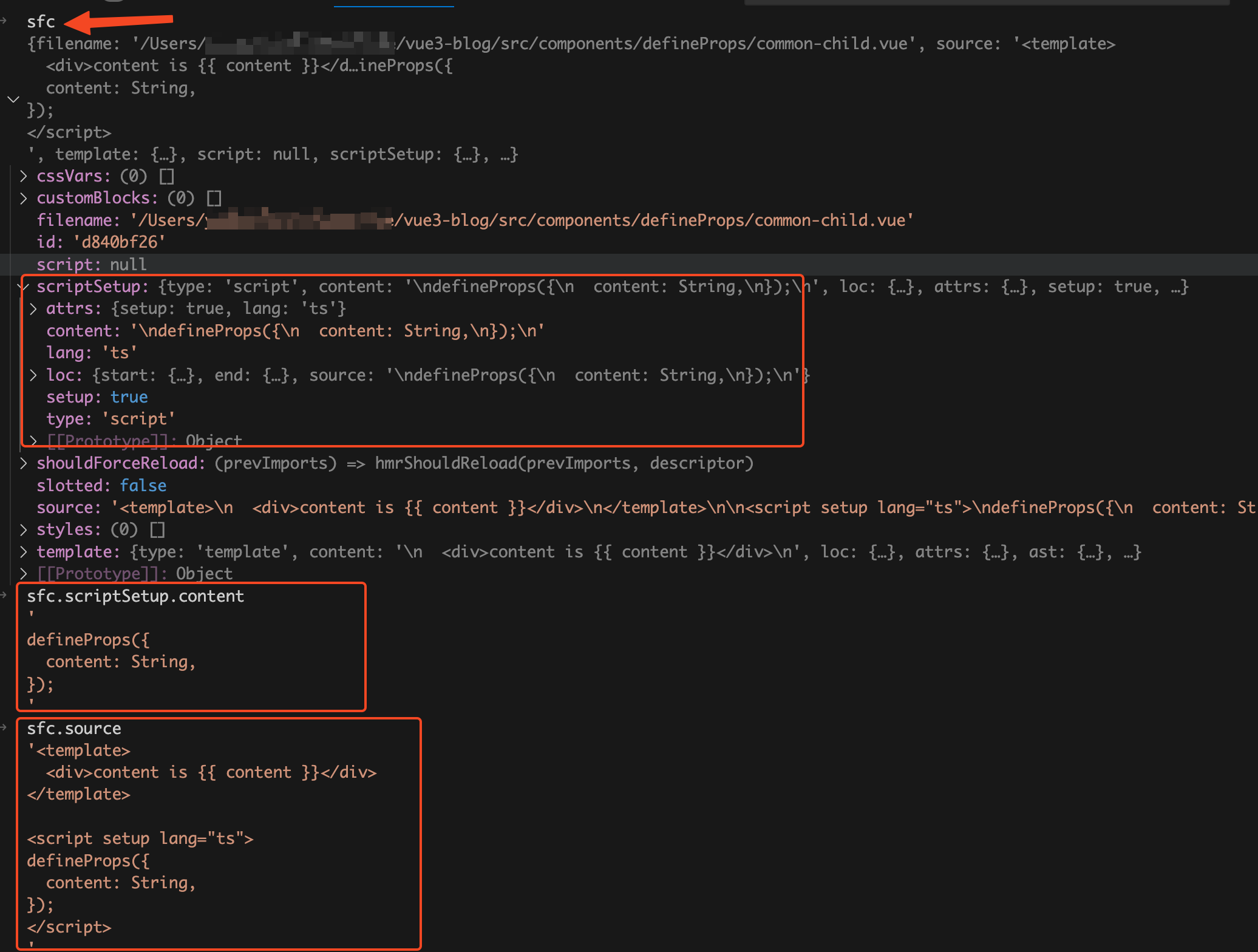
compileScript
函数内包含了编译
script
模块的所有的逻辑,代码很复杂,光是源代码就接近1000行。这篇文章我们不会去通读
compileScript
函数的所有功能,只会讲处理
defineProps
相关的代码。下面这个是我简化后的代码:
function compileScript(sfc, options) {
const ctx = new ScriptCompileContext(sfc, options);
const startOffset = ctx.startOffset;
const endOffset = ctx.endOffset;
const scriptSetupAst = ctx.scriptSetupAst;
for (const node of scriptSetupAst.body) {
if (node.type === "ExpressionStatement") {
const expr = node.expression;
if (processDefineProps(ctx, expr)) {
ctx.s.remove(node.start + startOffset, node.end + startOffset);
}
}
if (node.type === "VariableDeclaration" && !node.declare || node.type.endsWith("Statement")) {
// ....
}
}
ctx.s.remove(0, startOffset);
ctx.s.remove(endOffset, source.length);
let runtimeOptions = ``;
const propsDecl = genRuntimeProps(ctx);
if (propsDecl) runtimeOptions += `\n props: ${propsDecl},`;
const def =
(defaultExport ? `\n ...${normalScriptDefaultVar},` : ``) +
(definedOptions ? `\n ...${definedOptions},` : "");
ctx.s.prependLeft(
startOffset,
`\n${genDefaultAs} /*#__PURE__*/${ctx.helper(
`defineComponent`
)}({${def}${runtimeOptions}\n ${
hasAwait ? `async ` : ``
}setup(${args}) {\n${exposeCall}`
);
ctx.s.appendRight(endOffset, `})`);
return {
//....
content: ctx.s.toString(),
};
}
在
compileScript
函数中首先调用
ScriptCompileContext
类生成一个
ctx
上下文对象,然后遍历
vue
文件的
<script setup>
模块生成的
AST抽象语法树
。如果节点类型为
ExpressionStatement
表达式语句,那么就执行
processDefineProps
函数,判断当前表达式语句是否是调用
defineProps
函数。如果是那么就删除掉
defineProps
调用代码,并且将调用
defineProps
函数时传入的参数对应的
node
节点信息存到
ctx
上下文中。然后从参数
node
节点信息中拿到调用
defineProps
宏函数时传入的
props
参数的开始位置和结束位置。再使用
slice
方法并且传入开始位置和结束位置,从
<script setup>
模块的代码字符串中截取到
props
定义的字符串。然后将截取到的
props
定义的字符串拼接到
vue
组件对象的字符串中,最后再将编译后的
setup
函数代码字符串拼接到
vue
组件对象的字符串中。
ScriptCompileContext
类
ScriptCompileContext
类中我们主要关注这几个属性:
startOffset
、
endOffset
、
scriptSetupAst
、
s
。先来看看他的
constructor
,下面是我简化后的代码。
import MagicString from 'magic-string'
class ScriptCompileContext {
source = this.descriptor.source
s = new MagicString(this.source)
startOffset = this.descriptor.scriptSetup?.loc.start.offset
endOffset = this.descriptor.scriptSetup?.loc.end.offset
constructor(descriptor, options) {
this.s = new MagicString(this.source);
this.scriptSetupAst = descriptor.scriptSetup && parse(descriptor.scriptSetup.content, this.startOffset);
}
}
在前面我们已经讲过了
descriptor.scriptSetup
对象就是由
vue
文件中的
<script setup>
模块编译而来,
startOffset
和
endOffset
分别就是
descriptor.scriptSetup?.loc.start.offset
和
descriptor.scriptSetup?.loc.end.offset
,对应的是
<script setup>
模块在
vue
文件中的开始位置和结束位置。
descriptor.source
的值就是
vue
文件中的源代码code字符串,这里以
descriptor.source
为参数
new
了一个
MagicString
对象。
magic-string
是由
svelte
的作者写的一个库,用于处理字符串的
JavaScript
库。它可以让你在字符串中进行插入、删除、替换等操作,并且能够生成准确的
sourcemap
。
MagicString
对象中拥有
toString
、
remove
、
prependLeft
、
appendRight
等方法。
s.toString
用于生成返回的字符串,我们来举几个例子看看这几个方法你就明白了。
s.remove( start, end )
用于删除从开始到结束的字符串:
const s = new MagicString('hello word');
s.remove(0, 6);
s.toString(); // 'word'
s.prependLeft( index, content )
用于在指定
index
的前面插入字符串:
const s = new MagicString('hello word');
s.prependLeft(5, 'xx');
s.toString(); // 'helloxx word'
s.appendRight( index, content )
用于在指定
index
的后面插入字符串:
const s = new MagicString('hello word');
s.appendRight(5, 'xx');
s.toString(); // 'helloxx word'
我们接着看
constructor
中的
scriptSetupAst
属性是由一个
parse
函数的返回值赋值,
parse(descriptor.scriptSetup.content, this.startOffset)
,
parse
函数的代码如下:
import { parse as babelParse } from '@babel/parser'
function parse(input: string, offset: number): Program {
try {
return babelParse(input, {
plugins,
sourceType: 'module',
}).program
} catch (e: any) {
}
}
我们在前面已经讲过了
descriptor.scriptSetup.content
的值就是
vue
文件中的
<script setup>
模块的代码
code
字符串,
parse
函数中调用了
babel
提供的
parser
函数,将
vue
文件中的
<script setup>
模块的代码
code
字符串转换成
AST抽象语法树
。
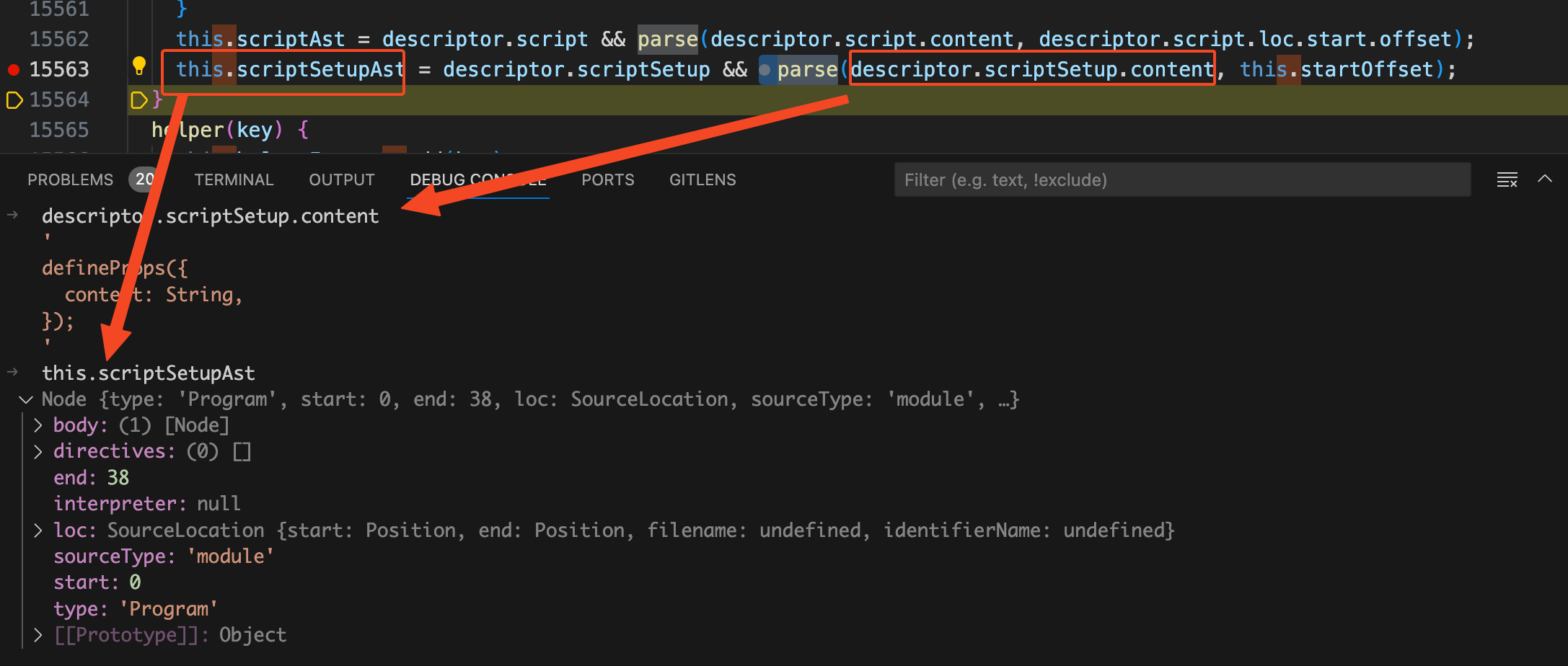
现在我们再来看
compileScript
函数中的这几行代码你理解起来就没什么难度了,这里的
scriptSetupAst
变量就是由
vue
文件中的
<script setup>
模块的代码转换成的
AST抽象语法树
。
const ctx = new ScriptCompileContext(sfc, options);
const startOffset = ctx.startOffset;
const endOffset = ctx.endOffset;
const scriptSetupAst = ctx.scriptSetupAst;
流程图如下:
processDefineProps
函数
我们接着将断点走到
for
循环开始处,代码如下:
for (const node of scriptSetupAst.body) {
if (node.type === "ExpressionStatement") {
const expr = node.expression;
if (processDefineProps(ctx, expr)) {
ctx.s.remove(node.start + startOffset, node.end + startOffset);
}
}
}
遍历
AST抽象语法树
,如果当前节点类型为
ExpressionStatement
表达式语句,并且
processDefineProps
函数执行结果为
true
就调用
ctx.s.remove
方法。这会儿断点还在
for
循环开始处,在控制台执行
ctx.s.toString()
看看当前的
code
代码字符串。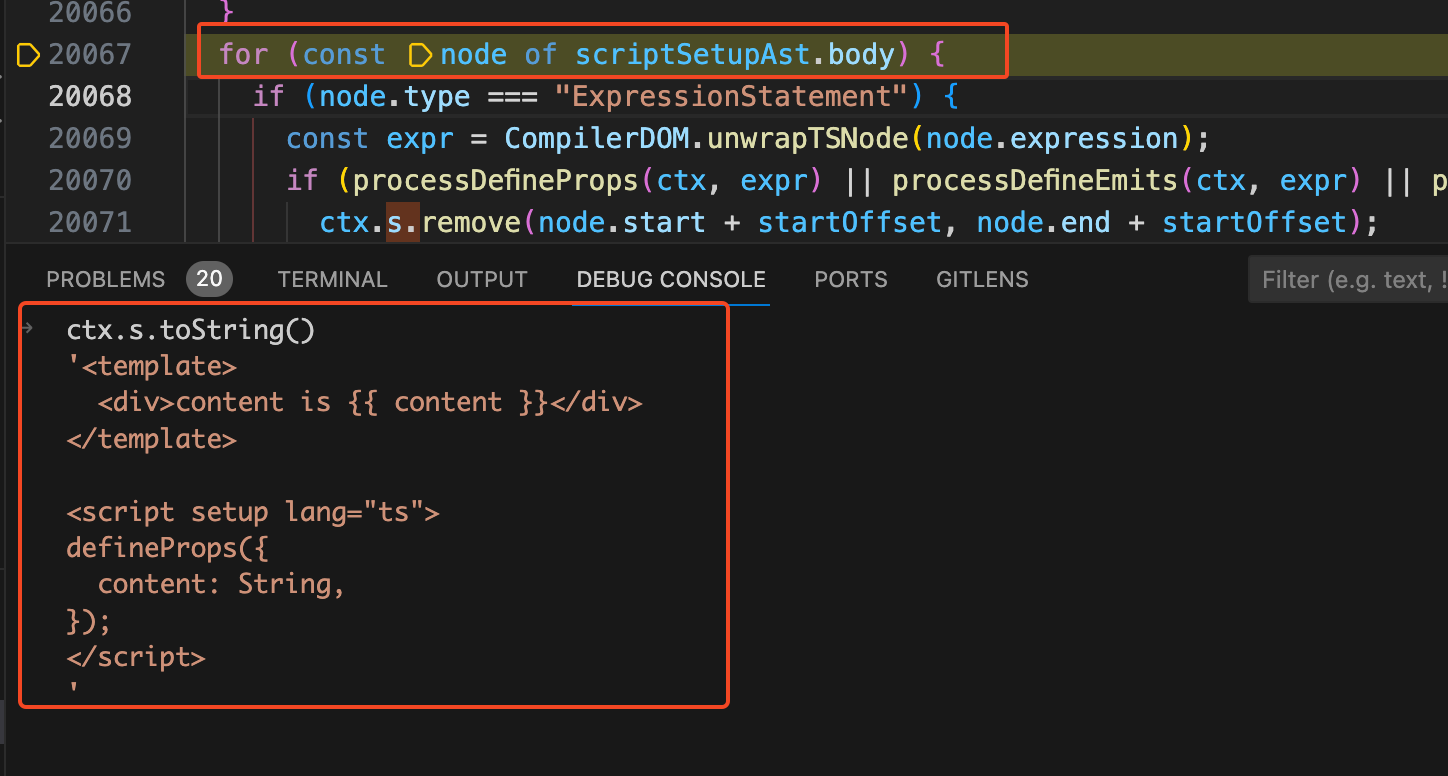
从图上可以看见此时
toString
的执行结果还是和之前的
common-child.vue
源代码是一样的,并且很明显我们的
defineProps
是一个表达式语句,所以会执行
processDefineProps
函数。我们将断点走到调用
processDefineProps
的地方,看到简化过的
processDefineProps
函数代码如下:
const DEFINE_PROPS = "defineProps";
function processDefineProps(ctx, node, declId) {
if (!isCallOf(node, DEFINE_PROPS)) {
return processWithDefaults(ctx, node, declId);
}
ctx.propsRuntimeDecl = node.arguments[0];
return true;
}
在
processDefineProps
函数中首先执行了
isCallOf
函数,第一个参数传的是当前的
AST语法树
中的
node
节点,第二个参数传的是
"defineProps"
字符串。从
isCallOf
的名字中我们就可以猜出他的作用是判断当前的
node
节点的类型是不是在调用
defineProps
函数,
isCallOf
的代码如下:
export function isCallOf(node, test) {
return !!(
node &&
test &&
node.type === "CallExpression" &&
node.callee.type === "Identifier" &&
(typeof test === "string"
? node.callee.name === test
: test(node.callee.name))
);
}
isCallOf
函数接收两个参数,第一个参数
node
是当前的
node
节点,第二个参数
test
是要判断的函数名称,在我们这里是写死的
"defineProps"
字符串。我们在
debug console
中将
node.type
、
node.callee.type
、
node.callee.name
的值打印出来看看。
从图上看到
node.type
、
node.callee.type
、
node.callee.name
的值后,可以证明我们的猜测是正确的这里
isCallOf
的作用是判断当前的
node
节点的类型是不是在调用
defineProps
函数。我们这里的
node
节点确实是在调用
defineProps
函数,所以
isCallOf
的执行结果为
true
,在
processDefineProps
函数中是对
isCallOf
函数的执行结果取反。也就是
!isCallOf(node, DEFINE_PROPS)
的执行结果为
false
,所以不会走到
return processWithDefaults(ctx, node, declId);
。
我们接着来看
processDefineProps
函数:
function processDefineProps(ctx, node, declId) {
if (!isCallOf(node, DEFINE_PROPS)) {
return processWithDefaults(ctx, node, declId);
}
ctx.propsRuntimeDecl = node.arguments[0];
return true;
}
如果当前节点确实是在执行
defineProps
函数,那么就会执行
ctx.propsRuntimeDecl = node.arguments[0];
。将当前
node
节点的第一个参数赋值给
ctx
上下文对象的
propsRuntimeDecl
属性,这里的第一个参数其实就是调用
defineProps
函数时给传入的第一个参数。为什么写死成取
arguments[0]
呢?是因为
defineProps
函数只接收一个参数,传入的参数可以是一个对象或者数组。比如:
const props = defineProps({
foo: String
})
const props = defineProps(['foo', 'bar'])
记住这个在
ctx
上下文上面塞的
propsRuntimeDecl
属性,后面生成运行时的
props
就是根据
propsRuntimeDecl
属性生成的。
至此我们已经了解到了
processDefineProps
中主要做了两件事:判断当前执行的表达式语句是否是
defineProps
函数,如果是那么将解析出来的
props
属性的信息塞的
ctx
上下文的
propsRuntimeDecl
属性中。
我们这会儿来看
compileScript
函数中的
processDefineProps
代码你就能很容易理解了:
for (const node of scriptSetupAst.body) {
if (node.type === "ExpressionStatement") {
const expr = node.expression;
if (processDefineProps(ctx, expr)) {
ctx.s.remove(node.start + startOffset, node.end + startOffset);
}
}
}
遍历
AST语法树
,如果当前节点类型是
ExpressionStatement
表达式语句,再执行
processDefineProps
判断当前
node
节点是否是执行的
defineProps
函数。如果是
defineProps
函数就调用
ctx.s.remove
方法将调用
defineProps
函数的代码从源代码中删除掉。此时我们在
debug console
中执行
ctx.s.toString()
,看到我们的
code
代码字符串中已经没有了
defineProps
了: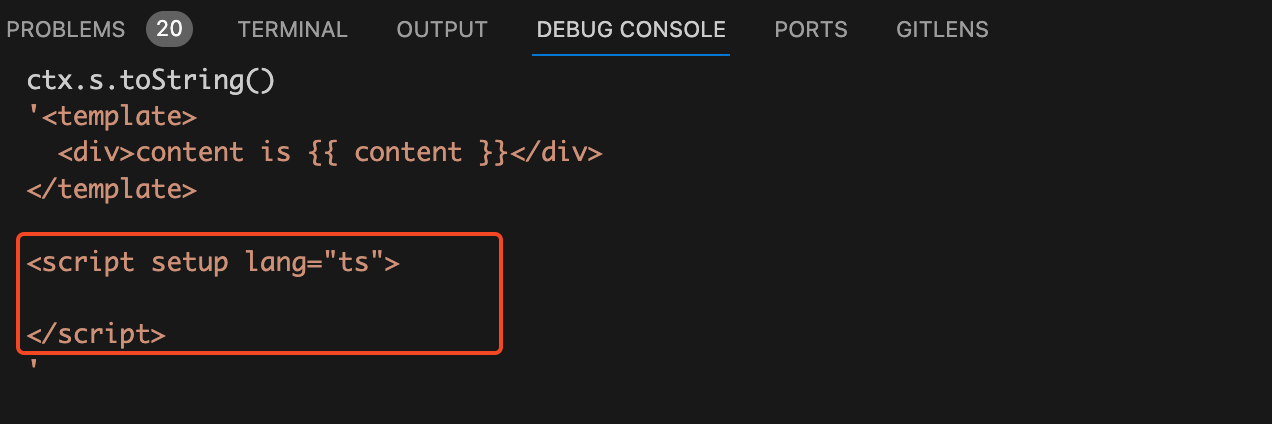
现在我们能够回答第一个问题了:
为什么
defineProps
不需要
import
导入?
因为在编译过程中如果当前
AST抽象语法树
的节点类型是
ExpressionStatement
表达式语句,并且调用的函数是
defineProps
,那么就调用
remove
方法将调用
defineProps
函数的代码给移除掉。既然
defineProps
语句已经被移除了,自然也就不需要
import
导入了
defineProps
了。
genRuntimeProps
函数
接着在
compileScript
函数中执行了两条
remove
代码:
ctx.s.remove(0, startOffset);
ctx.s.remove(endOffset, source.length);
这里的
startOffset
表示
script
标签中第一个代码开始的位置, 所以
ctx.s.remove(0, startOffset);
的意思是删除掉包含
<script setup>
开始标签前面的所有内容,也就是删除掉
template
模块的内容和
<script setup>
开始标签。这行代码执行完后我们再看看
ctx.s.toString()
的值:
接着执行
ctx.s.remove(endOffset, source.length);
,这行代码的意思是将
</script >
包含结束标签后面的内容全部删掉,也就是删除
</script >
结束标签和
<style>
模块。这行代码执行完后我们再来看看
ctx.s.toString()
的值:
由于我们的
common-child.vue
的
script
模块中只有一个
defineProps
函数,所以当移除掉
template
模块、
style
模块、
script
开始标签和结束标签后就变成了一个空字符串。如果你的
script
模块中还有其他
js
业务代码,当代码执行到这里后就不会是空字符串,而是那些
js
业务代码。
我们接着将
compileScript
函数中的断点走到调用
genRuntimeProps
函数处,代码如下:
let runtimeOptions = ``;
const propsDecl = genRuntimeProps(ctx);
if (propsDecl) runtimeOptions += `\n props: ${propsDecl},`;
从
genRuntimeProps
名字你应该已经猜到了他的作用,根据
ctx
上下文生成运行时的
props
。我们将断点走到
genRuntimeProps
函数内部,在我们这个场景中
genRuntimeProps
主要执行的代码如下:
function genRuntimeProps(ctx) {
let propsDecls;
if (ctx.propsRuntimeDecl) {
propsDecls = ctx.getString(ctx.propsRuntimeDecl).trim();
}
return propsDecls;
}
还记得这个
ctx.propsRuntimeDecl
是什么东西吗?我们在执行
processDefineProps
函数判断当前节点是否为执行
defineProps
函数的时候,就将调用
defineProps
函数的参数
node
节点赋值给
ctx.propsRuntimeDecl
。换句话说
ctx.propsRuntimeDecl
中拥有调用
defineProps
函数传入的
props
参数中的节点信息。我们将断点走进
ctx.getString
函数看看是如何取出
props
的:
getString(node, scriptSetup = true) {
const block = scriptSetup ? this.descriptor.scriptSetup : this.descriptor.script;
return block.content.slice(node.start, node.end);
}
我们前面已经讲过了
descriptor
对象是由
vue
文件编译而来,其中的
scriptSetup
属性就是对应的
<script setup>
模块。我们这里没有传入
scriptSetup
,所以
block
的值为
this.descriptor.scriptSetup
。同样我们前面也讲过
scriptSetup.content
的值是
<script setup>
模块
code
代码字符串。请看下图:
这里传入的
node
节点就是我们前面存在上下文中
ctx.propsRuntimeDecl
,也就是在调用
defineProps
函数时传入的参数节点,
node.start
就是参数节点开始的位置,
node.end
就是参数节点的结束位置。所以使用
content.slice
方法就可以截取出来调用
defineProps
函数时传入的
props
定义。请看下图:
现在我们再回过头来看
compileScript
函数中的调用
genRuntimeProps
函数的代码你就能很容易理解了:
let runtimeOptions = ``;
const propsDecl = genRuntimeProps(ctx);
if (propsDecl) runtimeOptions += `\n props: ${propsDecl},`;
这里的
propsDecl
在我们这个场景中就是使用
slice
截取出来的
props
定义,再使用
\n props: ${propsDecl},
进行字符串拼接就得到了
runtimeOptions
的值。如图:
看到
runtimeOptions
的值是不是就觉得很熟悉了,又有
name
属性,又有
props
属性。其实就是
vue
组件对象的
code
字符串的一部分。
name
拼接逻辑是在省略的代码中,我们这篇文章只讲
props
相关的逻辑,所以
name
不在这篇文章的讨论范围内。
现在我们能够回答前面提的第三个问题了。
defineProps
是如何将声明的
props
自动暴露给模板?
编译时在移除掉
defineProps
相关代码时会将调用
defineProps
函数时传入的参数
node
节点信息存到
ctx
上下文中。遍历完
AST抽象语法树后
,然后从上下文中存的参数
node
节点信息中拿到调用
defineProps
宏函数时传入
props
的开始位置和结束位置。再使用
slice
方法并且传入开始位置和结束位置,从
<script setup>
模块的代码字符串中截取到
props
定义的字符串。然后将截取到的
props
定义的字符串拼接到
vue
组件对象的字符串中,这样
vue
组件对象中就有了一个
props
属性,这个
props
属性在
template
模版中可以直接使用。

拼接成完整的浏览器运行时
js
代码
我们再来看
compileScript
函数中的最后一坨代码;
const def =
(defaultExport ? `\n ...${normalScriptDefaultVar},` : ``) +
(definedOptions ? `\n ...${definedOptions},` : "");
ctx.s.prependLeft(
startOffset,
`\n${genDefaultAs} /*#__PURE__*/${ctx.helper(
`defineComponent`
)}({${def}${runtimeOptions}\n ${
hasAwait ? `async ` : ``
}setup(${args}) {\n${exposeCall}`
);
ctx.s.appendRight(endOffset, `})`);
return {
//....
content: ctx.s.toString(),
};
这里先调用了
ctx.s.prependLeft
方法给字符串开始的地方插入了一串字符串,这串拼接的字符串看着脑瓜子痛,我们直接在
debug console
上面看看要拼接的字符串是什么样的: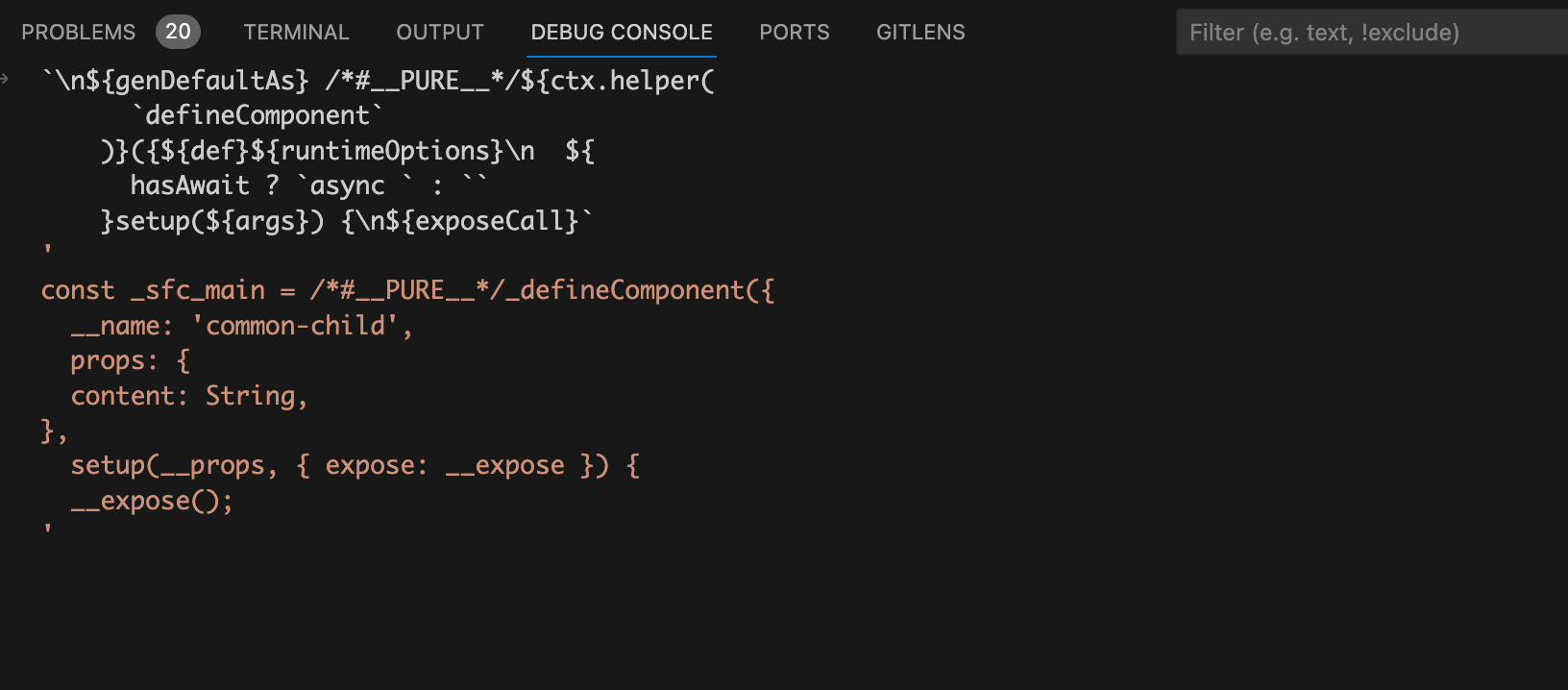
看到这串你应该很熟悉,除了前面我们拼接的
name
和
props
之外还有部分
setup
编译后的代码,其实这就是
vue
组件对象的
code
代码字符串的一部分。
当断点执行完
prependLeft
方法后,我们在
debug console
中再看看此时的
ctx.s.toString()
的值是什么样的:
从图上可以看到
vue
组件对象上的
name
属性、
props
属性、
setup
函数基本已经拼接的差不多了,只差一个
})
结束符号,所以执行
ctx.s.appendRight(endOffset,
})
);
将结束符号插入进去。
我们最后再来看看
compileScript
函数的返回对象中的
content
属性,也就是
ctx.s.toString()
,
content
属性的值就是
vue
组件中的
<script setup>
模块编译成浏览器可执行的
js
代码字符串。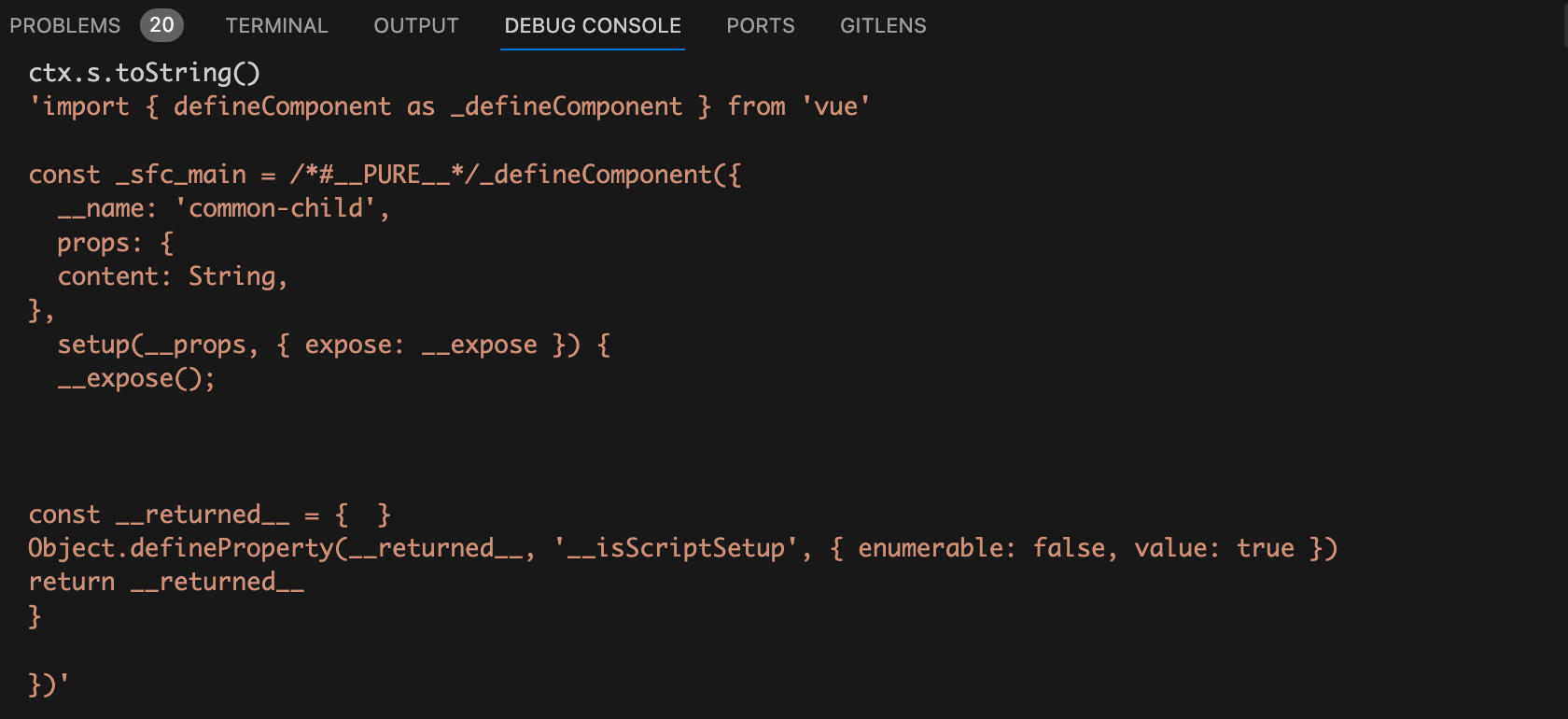
为什么不能在非
setup
顶层使用
defineProps
?
同样的套路我们来
debug
看看
if-child.vue
文件,先来回忆一下
if-child.vue
文件的代码。
<template>
<div>content is {{ content }}</div>
</template>
<script setup lang="ts">
import { ref } from "vue";
const count = ref(10);
if (count.value) {
defineProps({
content: String,
});
}
</script>
将断点走到
compileScript
函数的遍历
AST抽象语法树
的地方,我们看到
scriptSetupAst.body
数组中有三个
node
节点。
从图中我们可以看到这三个
node
节点类型分别是:
ImportDeclaration
、
VariableDeclaration
、
IfStatement
。很明显这三个节点对应的是我们源代码中的
import
语句、
const
定义变量、
if
模块。我们再来回忆一下
compileScript
函数中的遍历
AST抽象语法树
的代码:
function compileScript(sfc, options) {
// 省略..
for (const node of scriptSetupAst.body) {
if (node.type === "ExpressionStatement") {
const expr = node.expression;
if (processDefineProps(ctx, expr)) {
ctx.s.remove(node.start + startOffset, node.end + startOffset);
}
}
if (
(node.type === "VariableDeclaration" && !node.declare) ||
node.type.endsWith("Statement")
) {
// ....
}
}
// 省略..
}
从代码我们就可以看出来第三个
node
节点,也就是在
if
中使用
defineProps
的代码,这个节点类型为
IfStatement
,不等于
ExpressionStatement
,所以代码不会走到
processDefineProps
函数中,也不会执行
remove
方法删除掉调用
defineProps
函数的代码。当代码运行在浏览器时由于我们没有从任何地方
import
导入
defineProps
,当然就会报错
defineProps is not defined
。
总结
现在我们能够回答前面提的三个问题了。
为什么
defineProps
不需要
import
导入?因为在编译过程中如果当前
AST抽象语法树
的节点类型是
ExpressionStatement
表达式语句,并且调用的函数是
defineProps
,那么就调用
remove
方法将调用
defineProps
函数的代码给移除掉。既然
defineProps
语句已经被移除了,自然也就不需要
import
导入了
defineProps
了。为什么不能在非
setup
顶层使用
defineProps
?因为在非
setup
顶层使用
defineProps
的代码生成
AST抽象语法树
后节点类型就不是
ExpressionStatement
表达式语句类型,只有
ExpressionStatement
表达式语句类型才会走到
processDefineProps
函数中,并且调用
remove
方法将调用
defineProps
函数的代码给移除掉。当代码运行在浏览器时由于我们没有从任何地方
import
导入
defineProps
,当然就会报错
defineProps is not defined
。defineProps
是如何将声明的
props
自动暴露给模板?编译时在移除掉
defineProps
相关代码时会将调用
defineProps
函数时传入的参数
node
节点信息存到
ctx
上下文中。遍历完
AST抽象语法树后
,然后从上下文中存的参数
node
节点信息中拿到调用
defineProps
宏函数时传入
props
的开始位置和结束位置。再使用
slice
方法并且传入开始位置和结束位置,从
<script setup>
模块的代码字符串中截取到
props
定义的字符串。然后将截取到的
props
定义的字符串拼接到
vue
组件对象的字符串中,这样
vue
组件对象中就有了一个
props
属性,这个
props
属性在
template
模版中可以直接使用。
关注公众号:
前端欧阳
,解锁我更多
vue
干货文章,并且可以免费向我咨询
vue
相关问题。